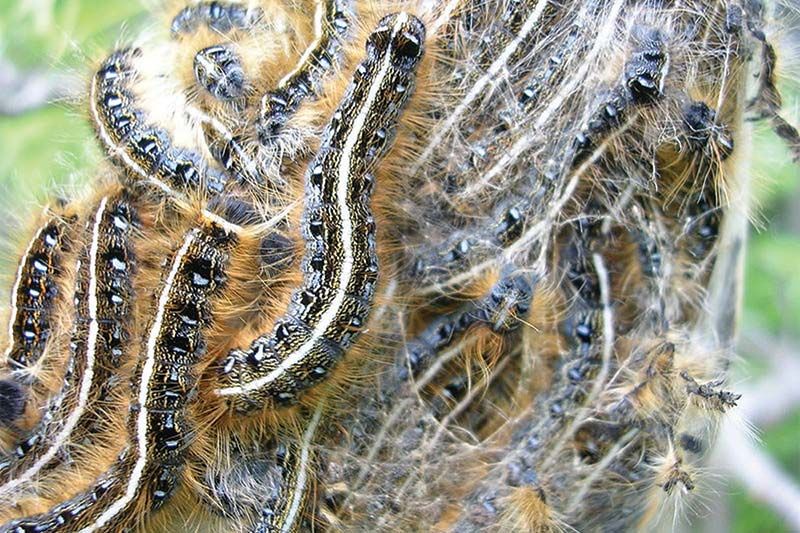Jun 14, 2017
I have strong childhood memories of gathering bluish hairy caterpillars and keeping them in jars until I became bored with that pursuit and my mother quietly released my captives. My attention span at the time wasn’t long enough to see what they would have become if I had looked after them longer.
It turns out they were forest tent caterpillars. If I had had more patience and watched them until they changed into adults, I would have been rewarded with a rather dull, medium-sized, reddish-brown moth. In retrospect, it wouldn’t have been much of a reward, so having plenty of other things to do with my precious summer probably saved me considerable disappointment.
We have two species of tent caterpillars in our area – the eastern tent caterpillar and the forest tent caterpillar. Both of these native insects hatch in early spring, feed intensively on leaves for several weeks, spin their wooly cocoons, emerge as adult moths in mid-July to mate, lay eggs and die. Although few birds prey on tent caterpillars, the two species of cuckoos we have in our area are hairy caterpillar specialists, and are known to be more common in areas where tent caterpillars are plentiful. For more information on cuckoos, see the August 13, 2009 Outdoors in the Land O’Lakes column on these interesting birds.
Only the eastern tent caterpillar builds an actual tent. Generally found on plants in the rose family, it is most often seen on various types of cherries and apples. The newly hatched caterpillars initiate the construction of a silk tent soon after emerging. They generally live together at the tent site for the whole of their larval life, expanding the tent each day to accommodate their increasing size. The full-grown larva is 40-50 mm (about 2 inches) in length, hairy and brownish black with blue spots along the body and a white stripe running the length of the back.
Forest tent caterpillars do not build tents, but instead gather together on silken mats that they spin on leaves or the bark of a tree. The full-grown larva is also about 40-50 in length, hairy and brownish black but with blue and orange longitudinal stripes and a row of pale, key-hole shaped spots along the centre of its back. This species will travel some distance in search of food, and mass migrations during outbreaks are common.
Both species are subject to periodic outbreaks, when populations may rise to incredible numbers. This is particularly true for forest tent caterpillars, where outbreaks occur every decade or so. This year seems to be an outbreak year in parts of our area. For example, in 2016 there were quite a few of the caterpillars around our house near Sharbot Lake, but this year the numbers are truly astounding. I recall one year in the early 1990s at our cottage on Bobs Lake when by mid June every leaf on every tree had been consumed. With sunlight streaming through the trees again, it felt more like late April than June. However, by early July the trees had valiantly put out a second crop of new, albeit smaller leaves.
I was worried that many trees would not survive the attack, but the following year there didn’t seem to be any increase in tree mortality. Fortunately tree mortality is usually low during an outbreak unless it lasts for several years in a row or happens during a severe drought. In our case, there wasn’t a single tent caterpillar to be seen anywhere the year after the population explosion – problem solved.
Tent caterpillar outbreaks are natural occurrences and controlling them is rarely either necessary or advised as outbreaks usually collapse on their own. However, limited protection of landscape trees from forest tent caterpillars can sometimes be achieved by gathering up and physically destroying large numbers of caterpillars when they are clustered together on tree trunks. Eastern tent caterpillars on fruit trees can be managed by pruning out the entire branch and sealing it in a black plastic garbage bag left out in the sun.
It will be interesting to see how many caterpillars we have next year – I’m hoping the outbreak will collapse after this year, but we’ll have to wait and see. Meanwhile, I’ll have to be content with cheering on the cuckoos to enjoy as much of this year’s all-you-can-eat caterpillar buffet as they can possibly manage!
More Stories
- All Candidates Meeting in Verona
- Summer Kickoff Music Festival’ Returns to South Frontenac
- Election 2025 Candidate Danielle Rae
- Election 2025 Candidate Michelle Foxton
- 1800s Blacksmithing Comes Alive at the South Frontenac Museum
- Tay Valley Choir Celebrates 20th Anniversary
- Mike’s Pizza in Sydenham
- South Frontenac Approves A New Official Plan
- CF Council Wants To Increase Severances To Stimulate Growth
- Annual Fool's Plunge

